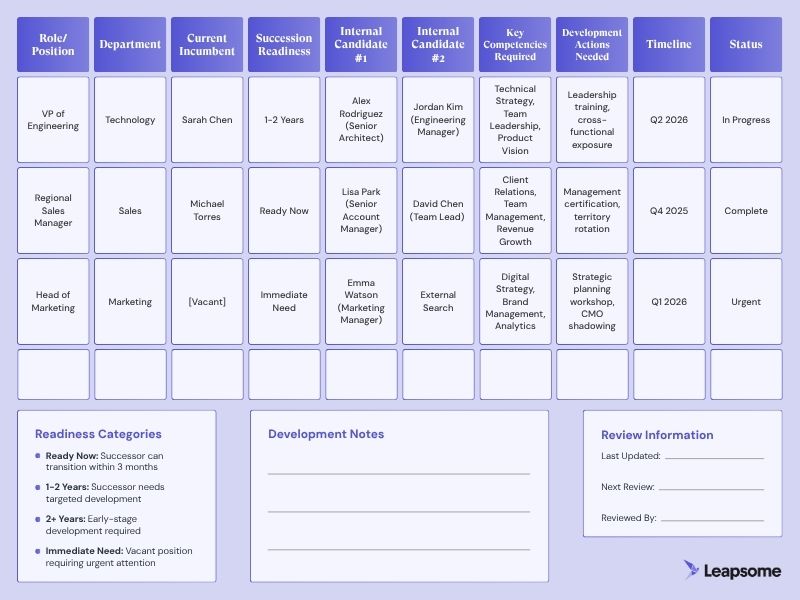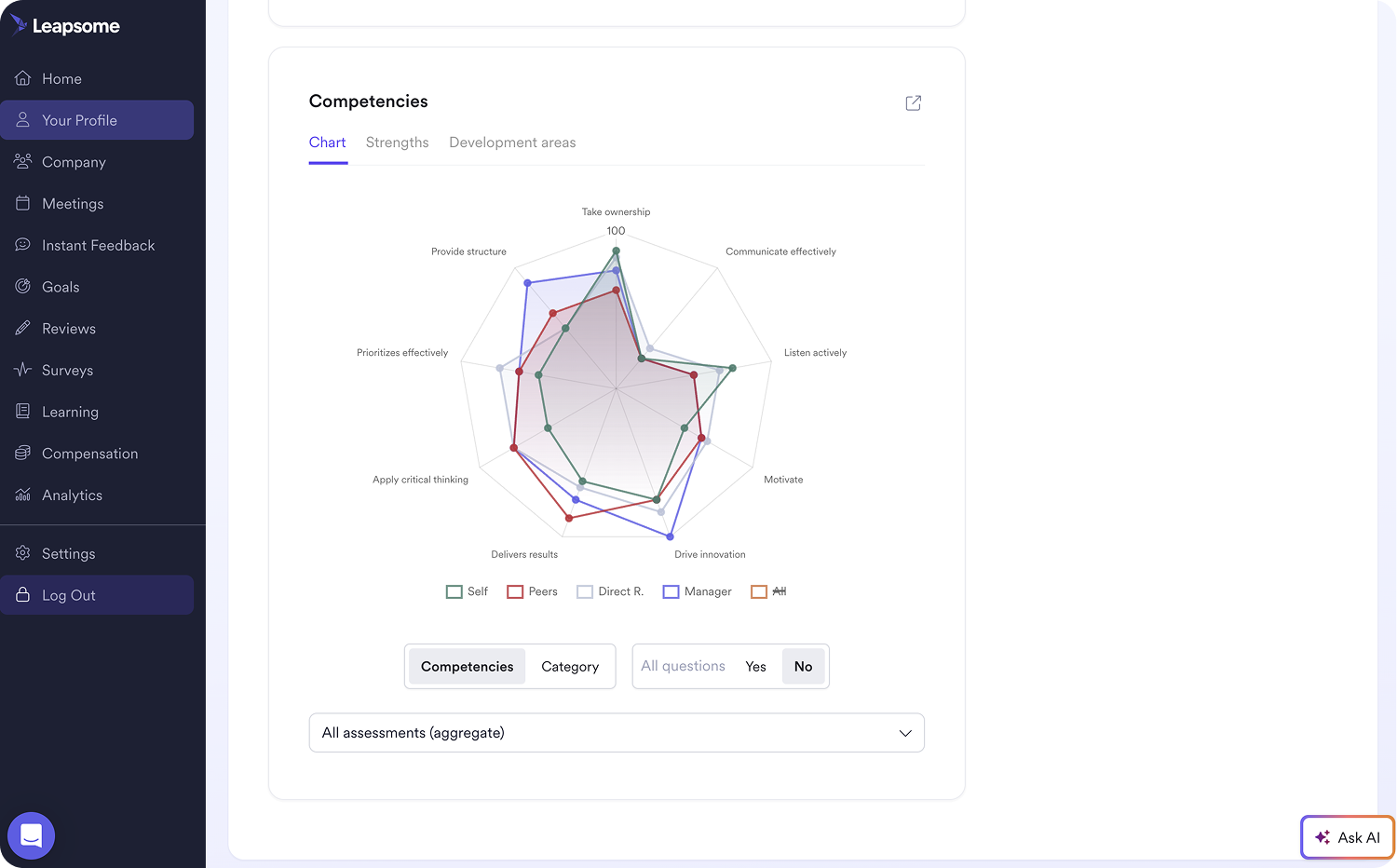The complete guide to succession planning

When your VP of Engineering announces their departure three weeks before a critical product launch, succession planning transforms from strategic nice-to-have into operational necessity. Organizations without structured leadership pipelines face recruiting delays, knowledge gaps, and project disruptions that impact revenue and team morale.
Most organizations recognize succession planning matters, yet implementation remains inconsistent. The gap between awareness and action creates organizational risk, while systematic approaches provide competitive advantage through reduced transition costs and stronger talent retention.
This guide provides the framework, tools, and real-world examples needed to build sustainable leadership pipelines that transform succession planning from reactive crisis management into proactive strategic advantage.
🏗️ Build systematic succession planning
Develop leadership pipelines that reduce transition risk and accelerate organizational growth.
👉Check out Leapsome’s competency framework
The succession planning process: Step-by-step guide
Succession planning transforms organizational uncertainty into strategic advantage. The most effective approaches don't wait for departures to trigger action — they build leadership readiness as an ongoing capability.
Essential steps for strategic succession planning:
- Map critical positions — Identify roles where vacancy creates operational risk or competitive disadvantage
- Evaluate internal talent — Assess current capabilities against future leadership requirements
- Design development pathways — Create targeted experiences that prepare successors for expanded responsibilities
- Establish knowledge transfer systems — Document institutional knowledge and decision-making frameworks
- Monitor progress and adapt — Regular reviews ensure plans evolve with changing business needs
- Integrate with performance management — Connect succession planning to existing talent processes for maximum efficiency
This framework addresses the reality that 70% of companies still operate without formal succession plans, despite mismanaged transitions costing organizations $1 trillion annually. Organizations that implement structured approaches gain competitive advantage through leadership continuity and reduced transition risks.
1. Identify critical roles and key positions
Effective succession planning starts with understanding which positions truly drive organizational success. Critical roles aren't necessarily the highest on the organizational chart — they're positions where departure creates disproportionate business risk or competitive disadvantage.
Organizations typically identify critical roles through several key factors:
- Revenue impact — Positions directly affecting major client relationships, product development, or market access
- Operational dependencies — Roles where specialized knowledge or relationships are difficult to replace quickly
- Strategic importance — Functions essential to competitive advantage or regulatory compliance
- Knowledge concentration — Positions where institutional memory resides with individual contributors
The most strategic organizations go beyond simply listing critical positions. They examine why each role matters and what specific risks vacancy would create. When a senior software architect leaves unexpectedly, product development might stall for months. If a key account manager departs, major client relationships could be jeopardized. This deeper understanding helps prioritize development investments and establish realistic succession timelines.
Technology transformation is reshaping which roles organizations consider mission-critical. Bridging the AI skills gap has become essential for many technical leadership positions, while traditionally stable roles now require new competencies to remain strategically relevant.
Successful succession planning connects role identification to broader talent development systems. Organizations that link critical position profiles to their existing career progression framework create clearer advancement pathways while ensuring succession planning aligns with ongoing development efforts.
2. Assess talent and skills gaps
Succession planning fails when organizations mistake current performance for future leadership potential. The VP who excels at quarterly execution might struggle with three-year strategic planning. The technical lead who solves complex problems might lack the influence skills to guide teams through organizational change.
Strategic talent assessment examines leadership readiness, adaptability, and growth capacity beyond today's contributions. Organizations that build systematic evaluation identify successors early and develop them strategically.
Critical assessment dimensions include:
- Leadership readiness — Ability to influence without authority and guide teams through disruption
- Technical evolution — Current capabilities relative to rapidly changing role requirements
- Cultural amplification — Capacity to model organizational values while driving performance
- Learning velocity — Speed of skill acquisition and knowledge transfer across contexts
AI upskilling has become central to succession conversations. Future leaders need both strategic thinking about AI's organizational impact and practical experience implementing AI-driven solutions. Skills matrices provide comprehensive evaluation by mapping current capabilities against future requirements.
For example, using Leapsome's competency frameworks, organizations can create dynamic skill assessments that automatically identify gaps between current leadership capabilities and role requirements, then generate targeted development recommendations based on real performance data.
.jpeg)
The data reveals significant organizational readiness gaps. More than three-quarters of HR professionals prioritize leadership development, yet only one in five organizations reports being effective at upskilling. This creates succession planning risk and competitive opportunity for organizations that build systematic assessment capabilities.
Effective assessment considers both current leadership skills and emerging requirements as AI transforms role expectations. Organizations winning at succession planning build ongoing evaluation into project assignments and stretch opportunities that reveal leadership potential under pressure.
3. Develop high-potential employees
High-potential employees demonstrate exceptional performance combined with the capability and motivation to advance to senior leadership roles. They typically show strong learning agility, influence skills beyond their current level, and the ability to think strategically about business challenges.
These individuals often display leadership behaviors before receiving formal leadership roles — they rally teams around shared goals, navigate ambiguity effectively, and consistently deliver results that exceed expectations. Identifying them early creates competitive advantage through targeted development investments.
Effective development approaches:
- Cross-functional rotation — Build organizational understanding and identify where strengths create maximum value
- Stretch assignments — Projects requiring new skills, stakeholder management, and decision-making authority
- Strategic exposure — Direct involvement in senior leadership conversations and planning processes
- External perspective — Industry networks and advisory opportunities that broaden thinking
SHRM data shows 63% of organizations invest in formal mentoring programs. With generational shifts and AI transformation accelerating through 2026, structured employee development methods become essential for knowledge transfer and leadership readiness.
Development happens through progressive responsibility, not classroom learning alone. High-potential employees need opportunities to make decisions, influence outcomes, and recover from mistakes within supported environments. Research shows that structured development programs reduce leadership transition failures by 30%.
Organizations that create these experiences early build stronger leadership pipelines and smoother succession transitions.
4. Create individual development plans
Generic leadership training produces generic leaders. High-potential employees need development roadmaps tailored to their specific strengths, gaps, and the unique requirements of their target roles.
Strategic development planning essentials:
- Role-specific competencies — Skills directly tied to target position requirements
- Experience-driven learning — Stretch assignments that build capabilities through application
- Progress metrics — Clear indicators of development success and readiness
- Accountability milestones — Regular checkpoints that maintain momentum
Effective employee development plans transform assessment insights into concrete action. The most successful approaches use proven development plan templates that balance organizational needs with individual career motivations. With Leapsome's individual development planning tools, HR teams can create customized development roadmaps that automatically track progress against succession readiness criteria while connecting to broader performance management cycles, ensuring development stays aligned with both organizational needs and individual career motivations.
Development plans succeed when they connect individual growth to business outcomes that matter. Organizations that demonstrate genuine investment through structured development retain top talent while building stronger leadership pipelines. Development plan examples show how targeted approaches create leaders who thrive during technological transformation.
The future belongs to organizations that view succession planning not as administrative necessity, but as strategic opportunity for human potential. Regular plan reviews ensure development stays aligned with changing business priorities and individual progress.
5. Implement knowledge transfer and mentoring programs
Institutional knowledge walks out the door every time a key leader leaves without structured handover processes. Organizations that treat knowledge transfer as an afterthought discover too late what they've lost — client relationships, decision-making frameworks, and strategic insights that took years to develop.
Strategic knowledge transfer approaches:
- Documented decision frameworks — Capture not just what decisions were made, but how and why
- Relationship mapping — Identify critical stakeholder connections and facilitate introductions
- Mentoring partnerships — Pair successors with current leaders well before transitions occur
- Process documentation — Record both formal procedures and informal workarounds that drive results
Development relationships cut transition risks by 30%, according to Center for Creative Leadership research. Organizations that establish mentoring relationships early create smoother leadership transitions and stronger institutional continuity.
Platforms like Leapsome systematize this through structured mentoring workflows where current leaders can document decision-making frameworks, track knowledge transfer progress, and ensure successors develop critical competencies through measurable development pathways rather than informal relationship building.
The most successful mentoring programs create structured interaction between current leaders and their potential successors. These relationships should begin months or years before transitions, allowing time for gradual knowledge transfer and relationship building that reduces transition risk.
6. Review and update the succession plan regularly
Some companies use tools like Leapsome to systematize knowledge transfer through structured development processes. For example, with Leapsome's competency frameworks and performance review systems, organizations can document the specific skills and decision-making approaches that make leaders effective, then track how successors develop these capabilities over time.
Real-world examples of successful succession planning
Effective succession planning adapts to both planned transitions and unexpected leadership challenges. Recent examples demonstrate how organizations use strategic succession approaches across different organizational levels.
Albertsons: Strategic long-term succession
Albertsons demonstrated structured succession planning when they announced Susan D. Morris would succeed CEO Vivek Sankaran in May 2025. The company followed a "ready-now" succession model with several key elements:
- Advance communication — Formal announcement in March with SEC filing, providing stakeholder clarity
- Internal development — Morris brought nearly 40 years of company experience across supply chain, manufacturing, and retail operations
- Cross-functional readiness — Seven years in senior operational roles, including COO since 2018
- Strategic continuity — Immediate emphasis on "Customers for Life" strategy upon appointment
The internal promotion reduced risk by elevating someone who understood culture, strategy, and operations. Public announcement and regulatory filing built trust with employees, investors, and stakeholders.
Kering/Gucci: Reactive but strategic succession
Kering's appointment of Francesca Bellettini as Gucci CEO shows how succession planning enables rapid response to leadership challenges:
- Internal readiness — Bellettini was already deputy CEO overseeing brand development
- Strategic involvement — She had shaped creative decisions, including recruiting designer Demna
- Governance restructuring — Eliminated confusing dual deputy CEO roles for clear authority
- Continuity focus — Combined stability through familiar leadership with urgency for sales turnaround
Even though corrective rather than planned, the transition minimized risk by elevating someone deeply embedded in strategic decision-making.
Middle management succession: The overlooked critical layer
Succession planning extends beyond executive roles to include middle management positions that drive daily operations. Consider a regional sales manager overseeing 15 direct reports and $20M in annual revenue. This manager has built relationships with key clients, understands territory-specific challenges, and mentors high-performing sales representatives.
Without succession planning, their departure creates cascading effects: client relationships weaken, team morale drops, and revenue targets become at risk. Smart organizations identify high-potential account managers or team leads, provide them with management training, client exposure, and cross-territory experience before transitions occur.
These mid-level succession plans require different approaches than executive succession — shorter development timelines, more tactical skill building, and closer integration with day-to-day operations.
Succession planning template: Your practical toolkit
Succession planning transforms organizational uncertainty into strategic advantage through systematic documentation and tracking of leadership readiness across critical roles.

The template captures three assessment dimensions: readiness timelines for transition planning, development actions to bridge capability gaps, and talent pipeline tracking with multiple candidates per role.
You can customize this template based on your organizational needs:
- Small companies (50-200 employees) — Focus on 5-8 critical roles, combine positions under single successors
- Mid-size organizations (200-1000 employees) — Expand to department-level planning with specialized development tracks
- Enterprise companies (1000+ employees) — Create separate templates by division with detailed competency frameworks
You can also leverage platforms like Leapsome to automate competency tracking, monitor development progress, and integrate succession planning with existing performance management systems. This reduces administrative burden while ensuring succession planning connects to broader talent development rather than existing as standalone documentation.
Regular template reviews ensure succession planning evolves with changing business priorities and technological requirements.
Technology-enabled succession planning: From documentation to development
Modern succession planning requires more than annual documentation. Organizations that transform succession planning into continuous development tracking gain competitive advantage through real-time readiness assessment and systematic capability building.
Technology platforms enable this transformation by connecting succession planning with broader talent development systems.
For instance, through Leapsome's integrated competency frameworks, automated development planning, and progress monitoring, organizations can maintain real-time succession readiness while reducing administrative burden and ensuring development stays aligned with changing business priorities.
This approach creates comprehensive talent ecosystems rather than isolated succession programs, enabling organizations to build adaptive capacity needed for technological transformation while creating stronger leadership pipelines.
The strategic value of succession planning for sustainable leadership

Succession planning represents more than risk mitigation. Organizations that build systematic leadership development create competitive differentiation through stronger bench strength, faster market adaptation, and improved talent retention.
Succession planning delivers measurable organizational benefits. Research confirms that structured approaches reduce leadership voids while improving continuity. Internal successors understand culture and strategy, enabling immediate contribution rather than lengthy orientation periods.
Current workforce challenges make succession planning increasingly critical. More than half of HR teams report working beyond capacity, creating strain that puts succession efforts at risk through 2026. Organizations that address capacity constraints through systematic processes gain sustainable advantage.
Modern succession planning requires integration with broader talent systems. Platforms like Leapsome connect succession planning with performance management, learning initiatives, and compensation planning, creating comprehensive talent ecosystems rather than isolated programs.
The future belongs to organizations that view succession planning not as administrative necessity, but as strategic opportunity for human potential. Organizations that invest early in systematic leadership development build the adaptive capacity needed to thrive during transformation while creating stronger leadership pipelines.
🏗️ Build systematic succession planning
Develop leadership pipelines that reduce transition risk and accelerate organizational growth.
👉 Check out Leapsome’s competency framework
Frequently asked questions about succession planning
What is succession planning? — Definitions and key concepts
Succession planning is the strategic process of identifying and developing internal talent to fill key leadership positions when they become vacant. Rather than scrambling during unexpected departures, organizations with robust succession plans have qualified candidates ready to step into critical roles.
Essential succession planning concepts include:
- Succession plan: The documented strategy outlining how specific roles will be filled, including timelines and development requirements
- Leadership succession planning: Focused preparation of successors for executive positions through multi-year development programs
- Talent pipeline: The pool of high-potential employees being prepared for advancement across departments
- Bench strength: The depth of qualified candidates available for promotion
- Critical roles: Positions essential to operations that would create significant impact if vacant
What is the difference between succession planning and replacement planning?
Succession planning is a strategic, long-term process that identifies and develops internal talent to fill future leadership roles. It focuses on building capabilities, providing development experiences, and preparing multiple candidates for advancement over time.
Replacement planning is a more immediate, tactical approach that identifies who would step into a role if someone left unexpectedly. While replacement planning addresses short-term continuity, succession planning builds sustainable leadership pipelines through systematic development and preparation.
How often should organizations review their succession plans?
Organizations should conduct formal succession plan reviews quarterly, with annual comprehensive assessments that align with business planning cycles. However, succession planning requires ongoing attention through regular talent discussions, development progress tracking, and adjustment for changing business priorities.
Technology transformation and market volatility make more frequent reviews essential. Organizations that treat succession planning as continuous conversation rather than annual administrative task create more responsive and effective leadership development.
What are the biggest challenges in implementing succession planning?
The most common succession planning challenges include resistance to change, difficulty identifying high-potential talent, limited resources for development programs, and lack of senior leadership commitment. Implementation research shows that organizations struggle with timing, measurement, and maintaining momentum over time.
Modern challenges include managing succession planning across hybrid teams, developing leaders who can navigate AI transformation, and balancing current performance with future potential. Organizations that address these barriers through systematic processes and technology integration achieve better succession outcomes.
Can small companies do succession planning effectively?
Small companies can implement highly effective succession planning by focusing on critical roles that would create operational risk if vacant. Rather than complex formal programs, small organizations benefit from identifying 3-5 key positions and developing targeted succession approaches.
Small company advantages include closer leadership relationships, faster decision-making, and more flexible development opportunities. Organizations with 50-200 employees should prioritize cross-training, mentoring relationships, and clear advancement pathways that demonstrate growth potential within limited hierarchical structures.
How does succession planning integrate with performance management?
Succession planning and performance management should work together to create comprehensive talent development systems. Performance reviews identify current capabilities and leadership potential, while succession planning translates these insights into targeted development experiences and advancement opportunities.
Effective integration connects succession readiness assessments with individual development goals, links advancement opportunities to performance outcomes, and ensures high-potential identification happens through systematic evaluation rather than informal observation. With Leapsome's integrated platform, succession readiness assessments automatically connect to performance review data, enabling organizations to identify high-potential employees through systematic evaluation while maintaining comprehensive development tracking.
Related articles
Back to the blogReady to transform
your People operations?
Automate, connect, and simplify all HR processes across the employee lifecycle.
.webp)
.webp)
 Request a demo today
Request a demo today






























